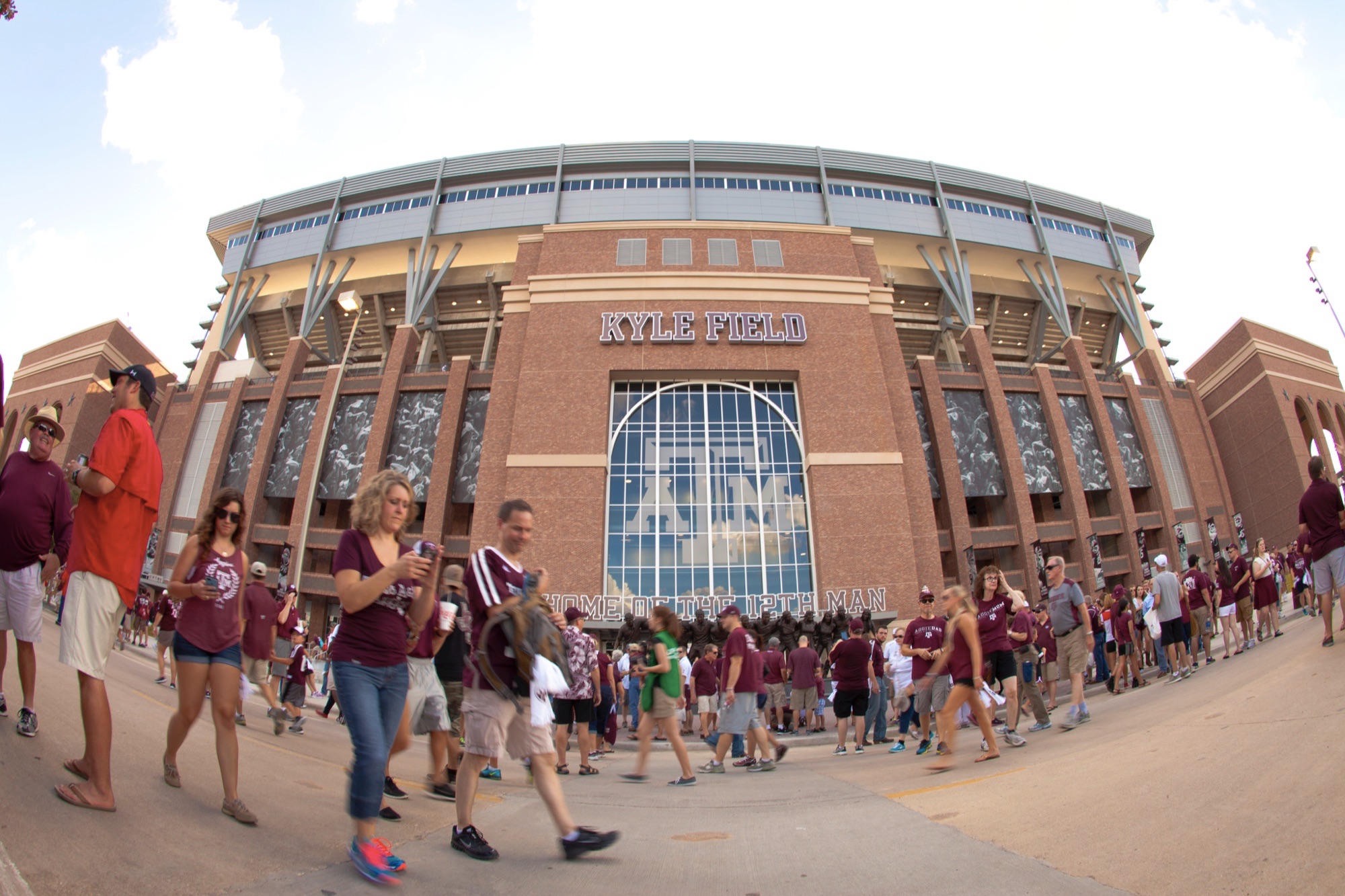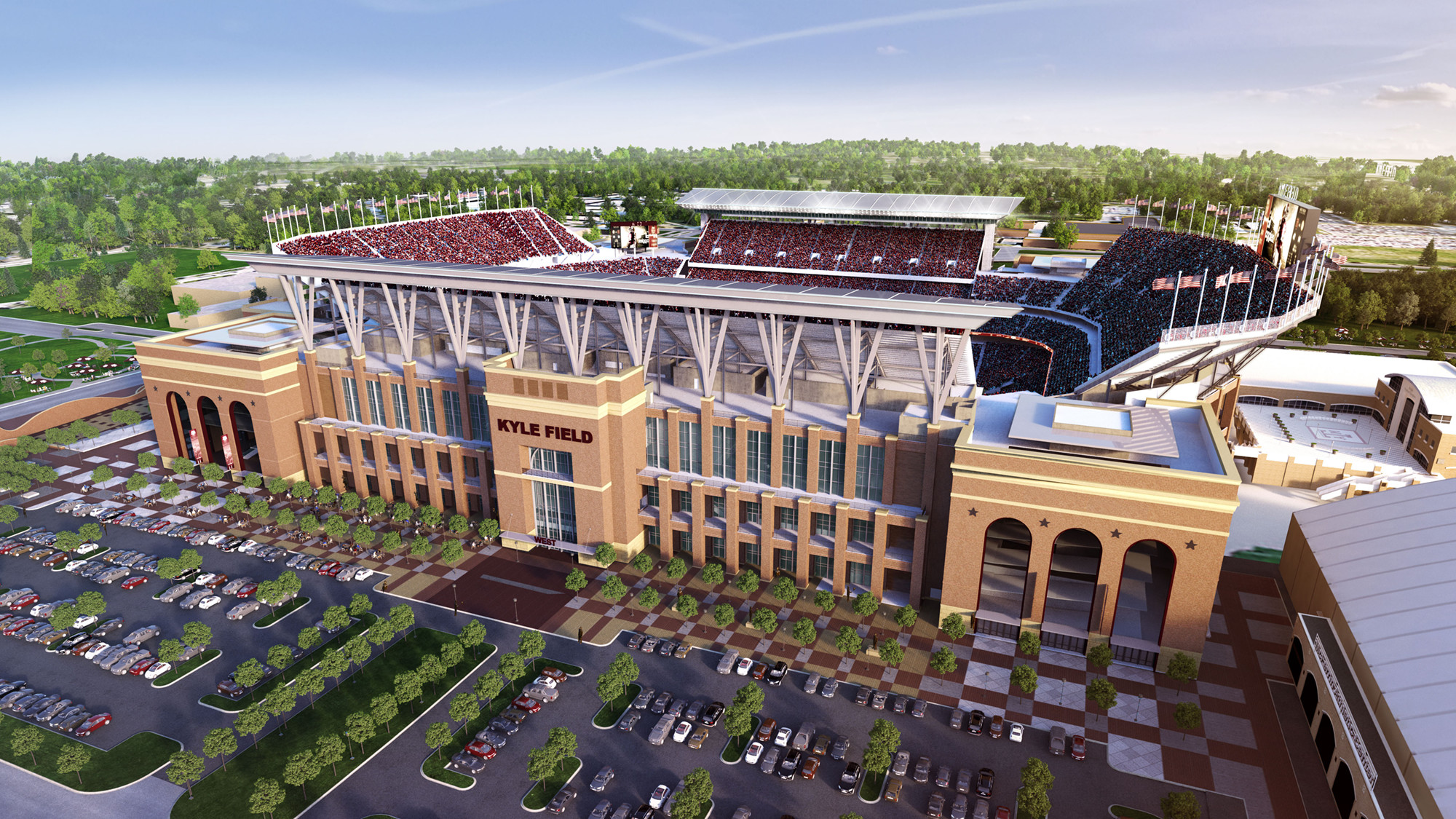With the dawn of a new college football season comes a facelift for Kyle Field, the home of the Texas A&M Aggies and one of the sport’s most historic facilities. When they face the Ball State Cardinals tomorrow night, the Aggies and their fans will participate in a new beginning for Kyle Field.
Starting at the conclusion of the 2013 season, the Texas A&M athletic department and Populous worked together on a $485-million renovation for Kyle Field, which has hosted football since the early 1900s and received its first permanent seating structure in 1927. Over the decades, the stadium has been renovated many times, with most improvements aimed at modernizing the seating bowl and increasing the facility’s capacity.
“We feel like iconic Kyle Field is our front porch to the nation and beyond,” said Phillip Ray, Texas A&M’s Vice Chancellor for Business Affairs. Ray, who also served as the Assistant Athletic Director from 2006 to 2008, said that while Kyle Field was already an integral part of the program, a modern facility would be needed to stay competitive in the robust SEC. “I did recognize that, in talking to others, that there was a lot of potential and a lot of opportunity if we had that vision.”
That vision ultimately focused on modernizing the stadium while honoring its traditions. Part of that heritage is the amplified game-day experience, which is one of the most unique in college football. The east side stadium has been—and remains—dedicated to the students, who are known for shaping the stadium’s atmosphere by standing and participating in hand signals and yells—usually led by the Yell Leaders. In order to hone their ritual before each game, the Aggies’ fans participate in the Midnight Yell, a rehearsal that is staged at Kyle Field the morning of every contest. Ray—who would not be surprised to see as many 60,000 fans turn out for the upcoming Midnight Yell—said it is not uncommon for as many as 40,000 students to turn out for games.
When handed with the task of preparing Kyle Field for a new era and upholding the program’s tradition, Populous had a particular goal in mind. “We wanted to not just maintain the history, but amplify it,” said project manager Craig Kaufman. Kaufman, who served as the renovation’s project manager said that while he was previously aware of this history, it was not until he visited A&M for the first time a few seasons ago that he got a sense of how the fans make the atmosphere. “It wasn’t until I went to the Alabama game a few years that I thought wow, they really take this stuff seriously here.”
Building off of that principle, the planners wanted to make the stadium more intimidating to opponents. Among the decisions that were made by Aggies’ officials included lowering the field to make the seating bowl closer to the action, constructing two new canopies to contain the stadium’s sound, and upgrade the stadium’s audio and visual presentations. “We feel ten-fold that [Kyle Field] is more intimidating,” said Ray.
Key to this vision were several leaders in the Aggies’ football program, including Head Coach Kevin Sumlin and Chancellor John Sharp, whom Ray credited as being a influential figure in shaping the direction to the renovation. “Every aspect that the chancellor looked at, one of the top factors would be enhancing the game day for the former students, the students, and the fans.”
Along with amplifying the stadium’s already rambunctious atmosphere, the Aggies and Populous added a new west-side structure that included premium seating areas and luxury suites. With the addition of new levels and seats, Kyle Field should now have a more inclusive feel. Prior to this upgrade, the stadium “almost looked like three or four different buildings,” said Kaufman. “One of our goals was to pull the pieces together, and make them feel, look, and act like a full stadium.”
Some of this work was done before the 2014 season, including most of the pieces for interior and exterior renovations to the east side and new seats on the stadium’s south end. Between the conclusion of the 2014 season and the start of this year, the north side was given an extensive facelift, a project that coincided with the west side upgrades. These improvements made Kyle Field the largest facility in the SEC, with The 12th Man Foundation announcing earlier this week that the stadium’s official capacity is 102,733.
Outside of the facility are a series of new plazas, which said Kaufman will serve as a year-round gathering place for members of A&M’s campus community. “The stadium itself is in the heart of campus. Campuses are very populated throughout the year, and part of the design allows those plazas to be used by students on a daily basis.”
Students will be able to complete their tasks outside of Kyle Field, as the area features numerous benches that are Wi-Fi accessible and feature device charging areas. Technology will also be a crucial piece inside of Kyle Field, which has a brand new fiber-based Wi-Fi system that Ray said will not only help game-day operations, but allow for improved access for fans and players.
The new west side will also house The Hall of Champions, which is one of the focal points among the additions to Kyle Field. Spanning the length of the field and standing three stories tall, The Hall of Champions serves a dual purpose for the university, as it is not only a museum dedicated to all of the university’s athletic programs, but acts as a year-round event center.
“The Hall of Champions is majestic,” said Ray. “We are extremely excited about this new amenity, not only about what it means to A&M but also the community.”
The center is also a testament to modern technology, as it will feature adjustable displays that can be customized according to the event, along with a wide range of graphics and video exhibits. Kaufman, who plans on attending Saturday’s opener, said that being able to take his son into The Hall of Champions is perhaps what he is most looking forward to the most, and he suspects that he will not be alone in that sentiment. “I can just see parents and former students bringing their kids here. It is going to be something of a different magnitude.”
When asked what he and Populous will take away from this project, Kaufman said that the collaborative process of working with the Aggies and honoring their traditions will always stand out. “We don’t design these stadiums for ourselves, we design it for them.”
“There’s no question that it’s going to enhance the game day environment,” said Ray, who added that the new facility “demonstrates the excellence of the Aggies.” He was also happy to say that the renovations will “make it the most intimidating environment in sports” for opponents.
Images courtesy Populous.


